We explore the Industrial Revolution, and describe its characteristics. In addition, we discuss its causes and effects.
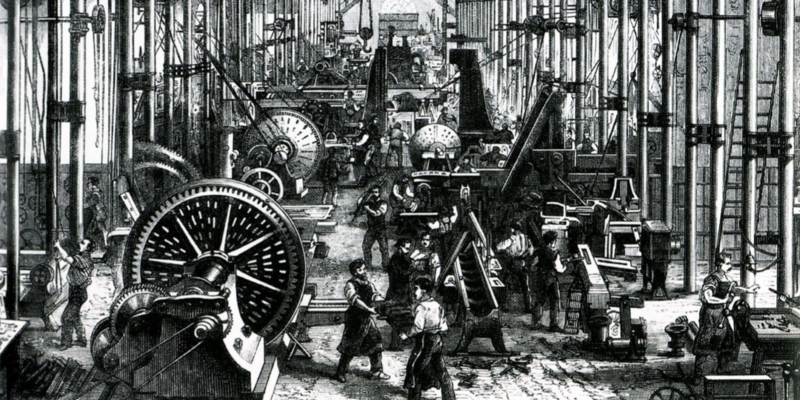
What was the Industrial Revolution?
The Industrial Revolution was a historical process of economic and social transformations that took place between 1760 and 1840, which led to unprecedented changes in Western societies and later, the whole world. To distinguish it from subsequent industrialization processes, it is often referred to as the First Industrial Revolution.
This process was characterized by the use of new technologies applied to mass production and the concentration of factories in cities. The most important invention of the period was the steam engine, fueled by coal, which increased production and transportation to unprecedented levels. Other important inventions included the spinning machine and the power loom, which made the manufacture of more textiles in less time possible.
The Industrial Revolution began in England, where a number of economic, political, social and technological factors had converged leading to this major change. Throughout the 19th century, it spread to other countries in Western Europe, as well as to the United States and Japan.
KEY POINTS
- The Industrial Revolution was a historical process of economic and social transformations leading to unprecedented changes.
- It began in England between 1760 and 1840, and later spread to most of the world.
- Major inventions included the steam engine, textile machinery, and gas street lighting.
- Craft production in workshops was replaced with mechanized manufacturing in factories.
- See also: Second Industrial Revolution
Characteristics of the Industrial Revolution
The main characteristics of the Industrial Revolution include:
- Large-scale industrial production, particularly in textiles, metallurgy, and food (thanks to the so-called Agricultural Revolution).
- The replacement of artisan workshops and the domestic system for the manufacture of products with the factory system (mechanized and based in factories).
- Mass migration from rural areas to cities.
- The enrichment of the bourgeoisie (industrial, commercial, and financial bourgeoisie) and its growing dominance over the economy and politics at the expense of the nobility.
- The emergence of a new social class: the working class.
- The development of technological innovations (such as the steam engine) and mechanized industries including textiles, metallurgy, iron and steel, and mining. The gradual substitution of steel for iron, a harder and more resistant iron-carbon alloy, which became more widespread during the Second Industrial Revolution.
- The development of global trade, as a result of the large production capacity and innovations in land and maritime transportation.
- The dominance of British capitalism, which benefited from international trade thanks to its maritime power and the access to cheap raw materials, particularly cotton from the Southern United States and India.
Origin of the Industrial Revolution
The Industrial Revolution began in England around 1760. The thriving commercial bourgeoisie, enriched as a result of British naval superiority, controlled colonial trade and, in addition, possessed other economic and political advantages that allowed them to set up factories and invest their capital in technological innovations.
The factory system, which was aimed at increasing productivity, changed the organization of work. This shift gave rise to large industrial cities like Manchester, Birmingham, Liverpool, and Sheffield.
This initial stage of innovations in manufacturing ended around 1840, and only three decades later, the next stage of the industrialization process began, often referred to as the Second Industrial Revolution.
Early industries of the Industrial Revolution
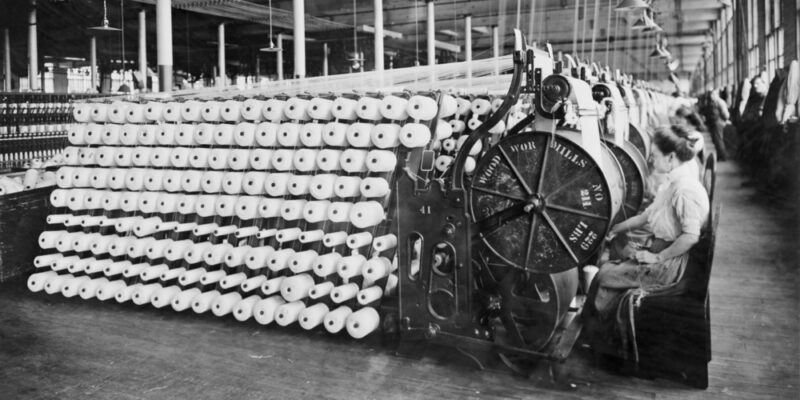
The Industrial Revolution originated in a number of important industries:
- Textile industry. Prior to the Industrial Revolution, textile production was already of great importance in Great Britain, operating mainly through the "putting-out" system, whereby a merchant capitalist provided tools and raw materials (wool or cotton) to rural families who wove textiles in their homes. The Industrial Revolution introduced machines such as the flying shuttle, the spinning jenny, Arkwright's water frame, and the power loom. These innovations led to the birth of the factory system, in which production was carried out in factories equipped with large machinery and large groups of wage workers. Thus, the textile industry reached an unprecedented scale.
- Mining industry. Starting in the 19th century, charcoal derived from wood was replaced by coke or coal. The latter was especially important, as it was the fuel used by steam engines in transportation (railroads and steamships) and factory production (especially to power furnaces in the metallurgical and iron and steel industries). This boosted the mining industry, which introduced the ventilation system and tramroads, while at the same time increased levels of labor exploitation and encouraged child labor (children fitted in the narrow paths leading into the mines).
- Metallurgical and iron and steel industries. Iron and steel were the primary raw materials of the period, used for the manufacture of agricultural tools, textile machinery, locomotives, railways, and ships. Iron and steel working became possible thanks to industrial furnaces operating at extremely high temperatures since they ran on coal. Though steel processing was first developed in 1740 in the steelworks of Sheffield (England), it was not until the mid-19th century and during the Second Industrial Revolution that its use became widespread.
- Transportation industry. Until the 18th century, the transportation system relied solely on horsepower and sailing. In the nineteenth century, there was a shift from horse-drawn transportation to steam-powered railroads thanks to the introduction of the steam engine and the development of the iron and steel industry, which made it possible to manufacture locomotives and railways. The railroad revolutionized trade and people transportation. The steamboat was also a major development of the time.
- Expansion of trade. The Industrial Revolution brought about unprecedented commercial growth that impacted the entire world. The introduction of railroads and the steamboat made the transportation of raw materials to manufacturing centers easier, as well as the movement of manufactured goods to domestic and foreign markets, even if that implied long distances. In this way, international trade expanded, benefiting the bourgeois sectors (especially in Great Britain) who engaged in industry and trade.
Causes of the Industrial Revolution
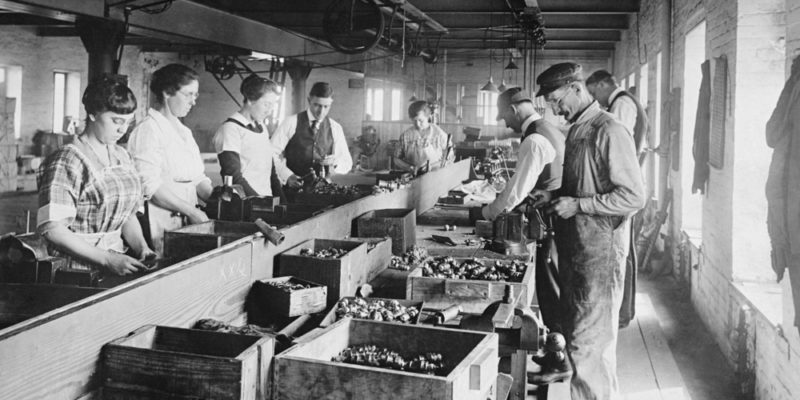
The Industrial Revolution was the result of the interaction of a number of factors that initially took place in England. The main causes of the Industrial Revolution were the agricultural revolution (which increased agricultural productivity), population growth, the migration of the rural population to cities, the availability of raw materials, the political rise of the bourgeoisie, and technological innovations (such as the steam engine).
The agricultural revolution
Until the 18th century, agriculture had not changed much since the Middle Ages. Manual labor and horsepower were used, there were common lands (belonging to the community and used for firewood and pastures), and production levels were modest due to the "fallow" system (which consisted of letting the land rest after harvest to regenerate soil nutrients).
The agricultural revolution brought about changes that expanded food availability and prompted mass migrations to cities:
- Machinery was first used for working the land. This evolved with the rise of industrialization.
- Open fields became privately-owned by large landowners through enclosure, driving landless peasants out and pushing them to seek factory jobs in cities.
- The old cropping system was replaced by the "Norfolk four-course system", which consisted of rotating crop varieties in order to avoid depleting the same soil nutrients continuously.
Population growth
Due to dietary changes, the population rose significantly from the 18th century onwards. When the Industrial Revolution began, the population increasingly concentrated in industrial cities.
The Industrial Revolution brought about changes that highly influenced population growth, such as decreased mortality (due to increased food supply), advances in medicine (the invention of vaccines, for example), and the consequent increase in the birth rate.
Availability of resources
England had two advantages that explain why industrialization began there. First, the English soil contained resources such as coal and iron that were vital for the transformation of manufacturing.
Secondly, thanks to its colonial ties and dominant position in world trade, the English had access to raw materials that were essential for the textile industry, especially cotton from India and the Southern United States.
Political influence of the bourgeoisie
Following the Glorious Revolution of 1688, a parliamentary monarchy was established in England that limited the power of the king and the nobility, while granting growing political power to the bourgeoisie.
As a result, measures favoring merchants and bankers were implemented, including the creation of the Bank of England. In other European countries, the seizure of political power by the liberal bourgeoisie only began in the late 18th century through more dramatic events, such as the French Revolution, which some historians include in the group of bourgeois revolutions.
The Industrial Revolution depended largely on the accumulation of capital by the English bourgeoisie, and also on certain economic liberalization laws that favored it. This enabled the rise of businesses and the circulation of capital, industrial growth through the defense of private property, technological innovation, and trade (often backed by British naval power).
Effects of the Industrial Revolution
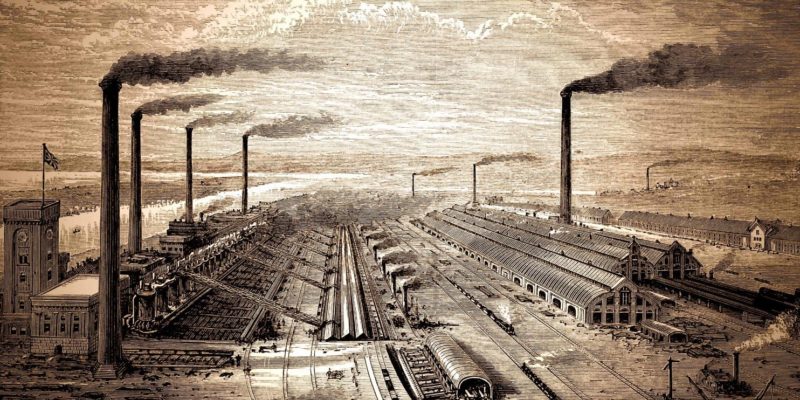
The Industrial Revolution brought about extraordinary changes in manufacturing processes, the organization of work, and the living conditions of the population. Among the consequences of the Industrial Revolution were the mechanization of factory work, the growth of cities, environmental pollution, the social division into two classes (bourgeoisie and working class), the economic and political rise of the bourgeoisie, the organization of labor and the rise of unions, and faster communication and transportation.
Mechanization in factories
Manual work in workshops was largely replaced by mechanized work in factories. This change accelerated production times, reduced costs, and improved performance.
At the same time, artisans were replaced by industrial workers who were employed by factory owners in exchange for a wage. In the early 19th century, a number of discontented workers known as the Luddites often destroyed machines as a form of protest against the replacement of artisan manufacturing. Nevertheless, factory work continued and expanded.
Rise of the bourgeoisie
The Industrial Revolution caused an enormous generation and accumulation of wealth, mostly concentrated in the bourgeois sectors that owned factories or engaged in trade and finance. This also influenced later innovations in technology and production that spread capitalism worldwide.
Growth of cities
As a result of the Industrial Revolution, the population of major urban conglomerates multiplied, leading to a marked gap between urban and rural areas. While scientific innovations brought about advances in health that resulted in population growth, population concentration facilitated the transmission of infectious diseases, particularly in working-class neighborhoods.
Environmental pollution
Urban life gave rise to the concentration of pollutants related to urban areas including organic waste and air pollutants from stoves. Both in the initial stage of industrialization and in the so-called Second Industrial Revolution, factory production relied heavily on the use of fuels, causing air pollution. In turn, the mass production of manufactured goods accelerated waste generation.
Division of labor and organized labor
The Industrial Revolution introduced the division of labor based on two social classes:
- The bourgeoisie: factory owners and of other means of production, they engaged in industry as well as in trade and finance.
- The working class: from both urban and rural areas, they exchanged their work in factories for a wage.
Before labor organizations such as unions were established to defend workers’ rights, no laws existed regulating the work of the working class.
Given that a large segment of the population was unemployed and had no economic resources, people accepted jobs under extremely unfavorable working conditions. Working hours were so long that they became unhealthy, and child labor was prevalent (often preferred by factory owners since children were paid lower wages).
Throughout the 19th century, harsh working conditions paved the way for organized labor and labor legislation, as well as the emergence of new political movements and ideologies (including socialism, anarchism, and communism) that motivated reforms in working conditions. However, many of the labor problems that arose with the Industrial Revolution continued to a greater or lesser degree into the early 20th century.
Inventions of the Industrial Revolution
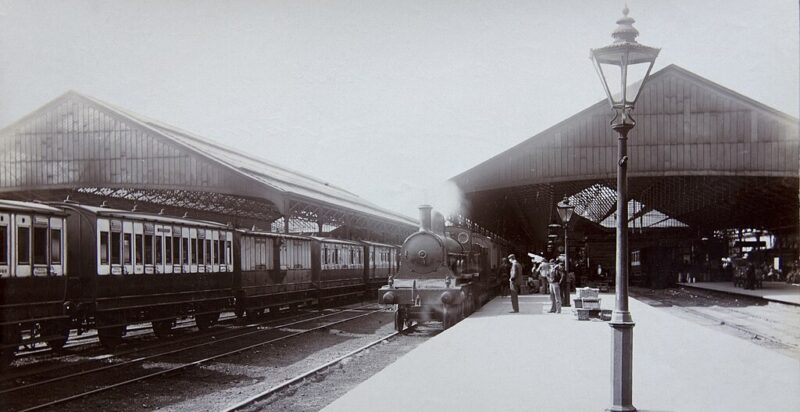
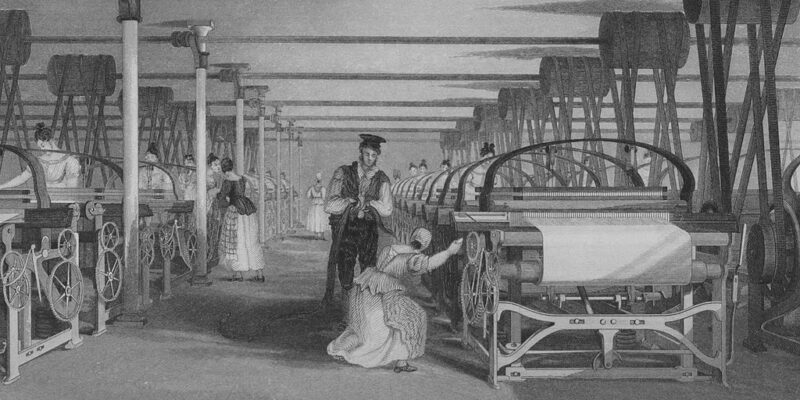
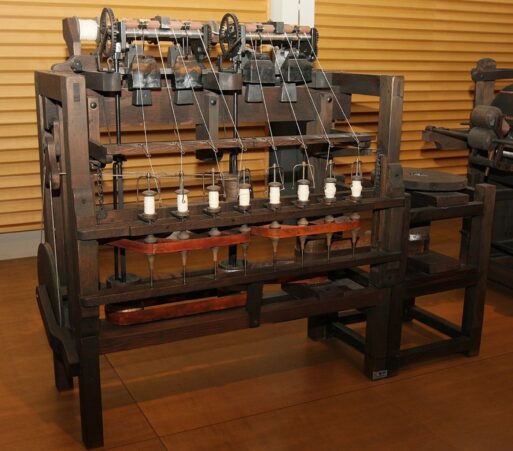
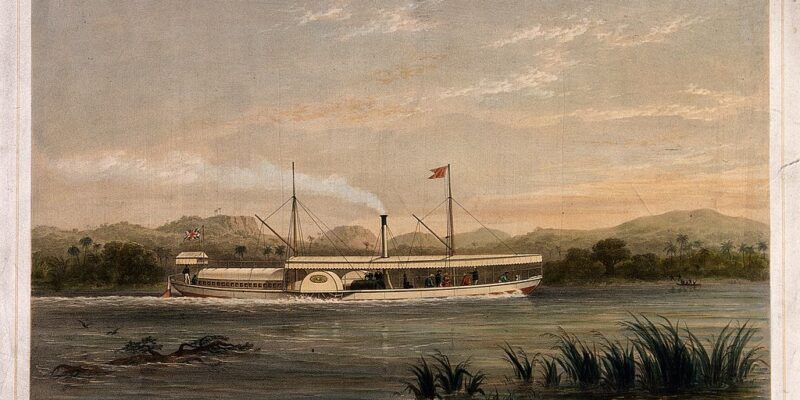
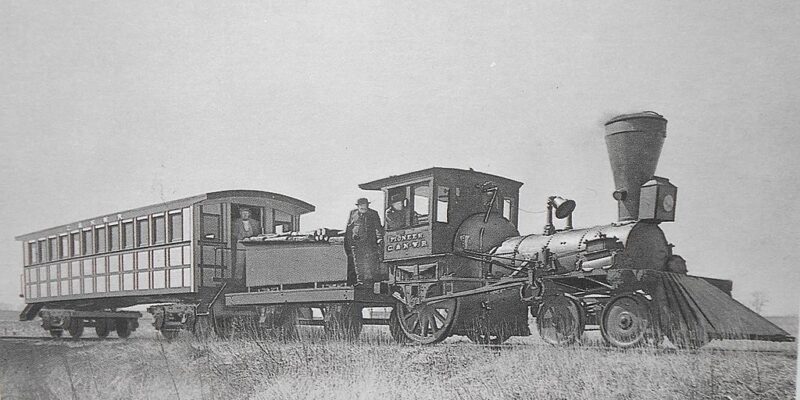
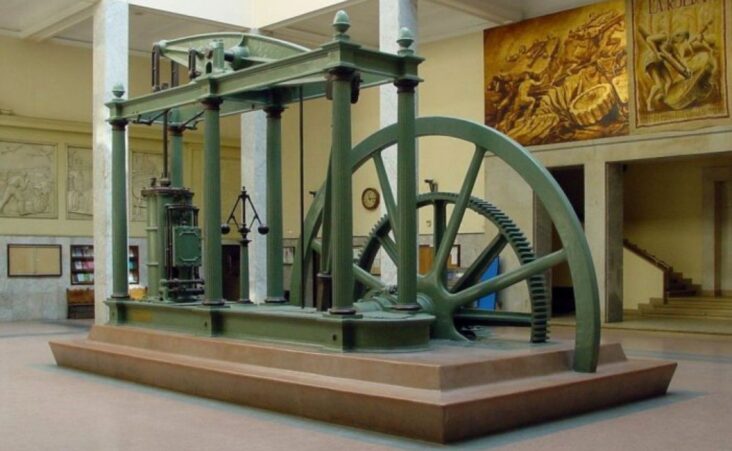
New technologies applied to production and transportation marked a turning point in the economy and society. Manual labor was replaced by the use of machines, while artisan workshops and work done in the household were largely replaced by large-scale manufacturing in factories. The main inventions that triggered the Industrial Revolution were textile machinery, the steam engine, and gas street lighting.
Steam engine
Patented in 1769 by the Scottish James Watt, the steam engine proved to be the most important invention of the Industrial Revolution. Its initial uses were:
- in transportation (it accelerated and improved the movement of raw materials and goods through railroads and steamships, and stimulated trade).
- in the textile industry (large-scale production rose through the use of machinery).
- in the metallurgical and iron and steel industry (it facilitated the pumping of coal mines, and iron and steel working).
Textile machinery
Innovation in the textile industry was the driving force behind the industrialization process, since it allowed both to expand the scale of production and reduce the time spent on each piece through the use of machinery. This meant lower production costs and higher profits for owners, which led to the accumulation and reinvestment of capital.
The most important inventions were the flying shuttle (created by John Kay in 1733), the spinning jenny (patented by James Hargreaves in 1770), the water frame (patented by Richard Arkwright in 1769), the power loom (introduced by Edward Cartwright in 1785), and the cotton gin (patented by Eli Whitney in 1794).
Gas street lighting
The introduction of gas lamps in streets revolutionized cities, which became safer places to circulate because they were lighted during hours with no sunlight (although thefts became frequent).
It also benefited factory owners, as workers could work longer hours thanks to artificial lighting, especially during the winter months. By the end of the Industrial Revolution, cities had been transformed, and their populations had doubled or tripled.
Stages of the Industrial Revolution
Although the first phase of the Industrial Revolution took place between 1760 and 1840, the process of industrialization continued throughout the 19th to 21st centuries. For this reason, some historians divide the Industrial Revolution into four stages.
First Industrial Revolution
The first stage of the Industrial Revolution occurred in England between 1760 and 1840. It introduced technological innovations that revolutionized production, transportation, and trade.
The main inventions were textile machinery and the steam engine. The latter allowed for the rise of railroads, steamships (which no longer had to rely on winds and currents), the smelting of iron with coke (fuel obtained from coal), as well as various machines. Industrialization replaced manual labor in workshops with mechanized work in factories.
Second Industrial Revolution
The second stage of the Industrial Revolution began in 1870 and ended in 1914, with the outbreak of World War I. It took place mainly in Western Europe, the United States, and Japan.
Among its characteristics were mass production by means of the assembly line, increased steel production, the use of new energy sources (oil, electricity), the invention of the automobile and the airplane, and the development of telecommunications (telephone, radio, phonograph, and cinematograph). These innovations led to increased productivity and mass consumption.
Third Industrial Revolution
The Third Industrial Revolution took place mainly during the 1970s and 1980s. It was marked by the introduction of digital and information technology in businesses, industrial automation (the use of automated machines for manufacturing), and the simplification of information processing.
It led to the creation of large multinational corporations, the trade of personal computers, the development of the Internet and the first cellular phones, and the rise of biotechnology and energy engineering.
Fourth Industrial Revolution
The concept of the Fourth Industrial Revolution makes reference to worldwide changes in technology and the economy starting in the early 21st century. Its main characteristics were the development of robotics and nanotechnology, advances in artificial intelligence and Big Data processing, embedded connectivity, and the widespread use of platforms for personal and work tasks.
Some scholars reject the concept on the grounds that they do not consider it a new revolution but rather a deepening of the Third Industrial Revolution.
Explore next:
- Causes and effects of the Industrial Revolution
- Third Industrial Revolution
- Fourth Industrial Revolution
References
- Britannica, Encyclopaedia (2022). Industrial Revolution. Encyclopedia Britannica. Britannica
- Hobsbawm, E. (2001). Industria e imperio. Crítica.
- Hunt, L., Martin, T. R., Rosenwein, B. H. & Smith, B. G. (2016). The Making of the West. Peoples and Cultures. 5th edition. Bedford/St. Martin’s.
- Rule, J. (1990). Clase obrera e industrialización. Crítica.
- Stokes Brown, C. (s.f.). The Industrial Revolution. Khan Academy. KhanAcademy
Was this information useful to you?
Yes NoThank you for visiting us :)